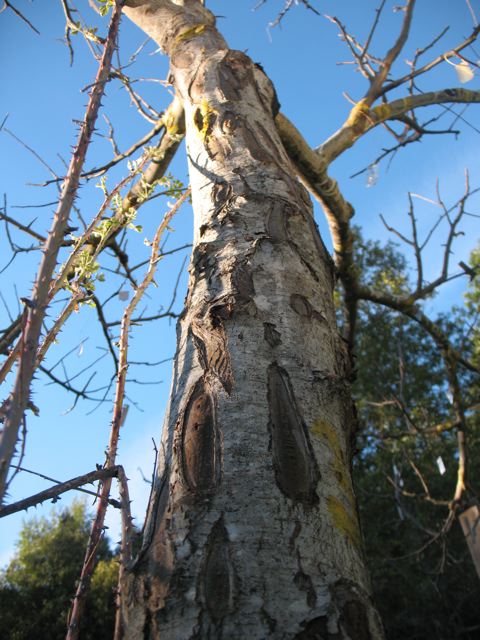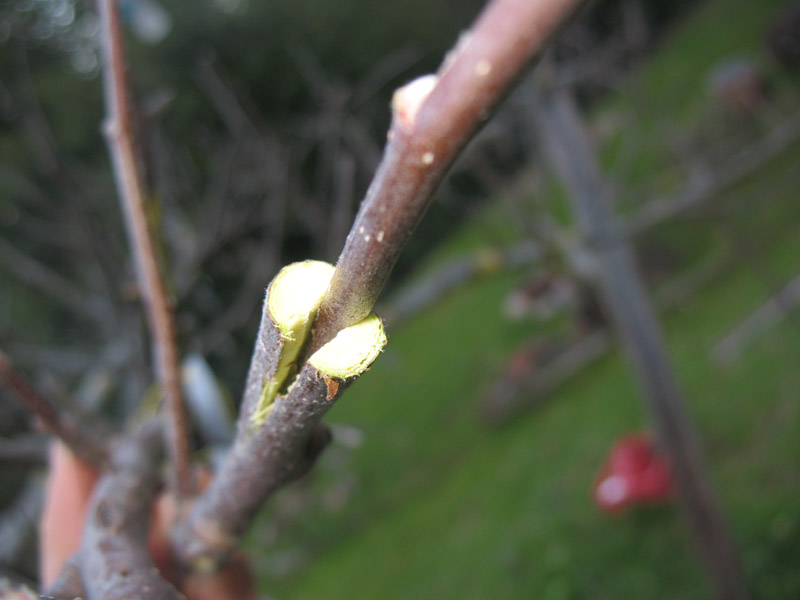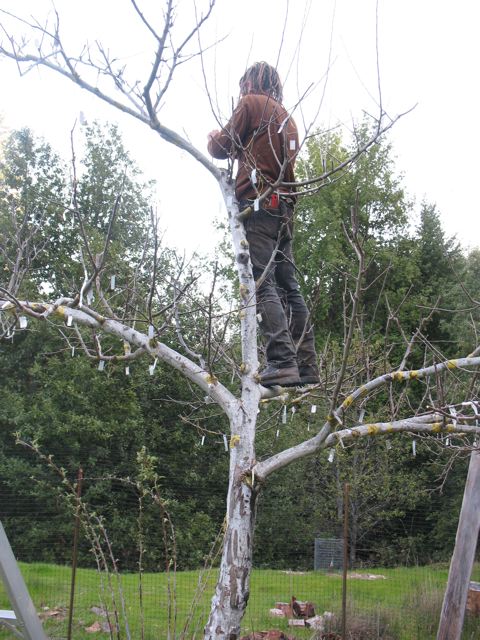Come February and March I rarely step outside without the essential pruning shears stuffed in my back pocket. The grafting knife gets sharpened and the fridge becomes crowded with scions (cuttings of wood from fruit trees) for grafting projects. At this time of year, most of my time seems to get used up planting, mulching, caging, pruning fertilizing, training, inspecting and grafting fruit and nut trees. And then there's !Frankentree!...
The owner planted an arkansas black apple some years back, but the top must have died and only the rootstock survived because the apples were small hard green things not fit for eating. Not if you're a spoiled human anyway. One day I found 4 to 6 inch claw marks covering one side of the tree up to 4 feet and more. Long curls of bark hung from the scratches. A few broken branches near the top told the story of a bear climbing the tree to get at the fruit. When I first saw this tree I was very excited because in spite of receiving no care whatsoever beyond establishment it was putting on good yearly growth and looked healthy and vigorous. I figured maybe some of the trees I intended to plant in the future might do this well without excessive pampering and was happy. Since the apples were useless I went straight away to the Scion exchange and collected a large pile of scions to work the tree over to different varieties. Every year in early to mid march Tamara and I go out to the !Frankentree! to add more varieties. I graft the scions onto the tree and she makes labels and takes notes to keep track of what we put on and when. As of today there are 84 distinct varieties (now 140), several unknowns from which the tags were lost or never put on and a few repeats. The tree had 20 plus varieties of actual fruits on it last year, but the Stellar's Jays pecked nearly all of them to complete ruins while they were still hard and green. As soon as acorns were ready enough they abandoned green apple eating and went to work on them. If the ignorant villagers don't come after her with pitchforks, axes and chainsaws for being an abomination of nature, I have high hopes for an abundant diversity of apples to taste this summer through winter.
I removed pretty much all the growth from the tree the first year and replaced it with apple varietals. Some people do this process in stages, but I don't think it's necessary if the tree is healthy and vigorous enough and if less crude methods than the usual are used. The usual top working method, known as topworking, involves loping off limbs 2 to 5 inches in diameter, splitting them open from the end and stuffing in a couple of scions cut to a wedge shape. This method leaves only a few new shoots per tree, and those few shoots have to grow out and gather sunlight for the whole tree. This method also leaves a large open wound which is not unlikely to become infected. This chainsaw and axe method of grafting over a whole tree is quick and cost effective, but the small scale orchardist can get fruit much faster and preserve the health of the tree at the same time by making lots of smaller cuts and putting on an equal number of longer scions, a technique known as frameworking.
At first I used a side graft method from the Grafter's Handbook that just didn't work that well. In this method you cut into the side of a main branch deeply at an angle. The scion is cut to a wedge shape similar to that used in cleft grafting (see pics below) and then simply stuffed tightly into the cleft which pinches it and holds it in place without any wrapping. It does have to be covered in grafting wax though. The success rate on these grafts was probably less than 50% which is very poor for apple, an easy to graft fruit. I also didn't like the fact that the branches then came out at an angle right along the parent branch instead of growing out and away from it. that makes a bark inclusion in the tight space between the parent branch and the new scion branch, which arrangement is both weaker and more disease prone. It is also very hard to line up the cambium layers in this method because the bark on the branch and the bark on the scion are very different thicknesses. I imagine one could get a better take with practice, but I still don't like the other drawbacks. The advantage is that you can put a new side branch on wherever you like, which is great when there doesn't happen to be a shoot to graft onto.
Since then I've done almost exclusively whip and tongue or cleft grafts which work great. I only use the side cut method above when I need a branch where there is no small stub to graft onto. Now that some of the older grafts are quite large I'm grafting material onto the ends of them to try out new stuff. If something fruits and I'm not impressed with it, it can be replaced by something new that I'd like to try out. I have a growing apple wish list large enough to require a couple more !Frankentrees! When adding scions I get the longest scions I can. Unfortunately people cut them short to fit into plastic ziploc bags, so they are usually shorter than I would like. I learned from the grafter's handbook to use long scions with 8 or 9 or more buds when top-working (working over an existing tree to new varieties) because they will fruit faster. When grafting onto a young roostock you need only two buds and one of them is just for insurance in case the other doesn't grow. I usually select the stronger of the two and pinch out the other early on. The rationale for using long scions in top-working is proved out by experience. If there are only a couple/few buds on the scion then they will all go vegetative and grow into long shoots. If the scion has many buds generally the ones near the tip will grow out into shoots and the shoot can afford to turn the lower buds into fruiting buds. I've actually gotten fruit the first year when there were already fruiting buds on the scion. That kind of precocity is unusual, but it's not unusual to get a few fruits the second year and a good little crop the third year. Early fruiting can also be encouraged by summer pruning. Pinching back any vegetative shoots that you don't require to grow long will encourage the formation of fruiting buds near the base of the shoot. Pinch a little off the tip when it has grown out pretty long and then come along once or twice more during the summer and prune it back yet further. At the end of the season you end up with a shorter shoot with the lower buds differentiating into fruiting buds. It seems to work pretty well on many varieties and helps to control the more vigorous growing types so that they don't take over the tree.
At some point !Frankentree! will hit some real world limit as to how many varieties you can practically fit on one tree and still expect to get good fruit from them. I use the tree somewhat for holding wood I might want later and early on I just wanted apples period. Now I'm more inclined to use it to test varieties I want to try. Many rare varieties are very difficult to find samples of for taste testing. Furthermore, even if you can find them there is no guarantee they will be in their best state, in fact, they usually won't be. some apples are best off the tree. Others ripen and improve with storage... some with lots of storage time, some with only a little. Some years they taste better than others. Besides, I want to know if the apple does well here and actually tastes good when grown in this climate, or stored until March or April or may. The Earliest apples on !Frankentree! so far are Red Astrachan in mid to late July and the latest is Lady Williams which should hang into February. The Jays knocked the last Lady Williams off the tree in mid January and it wasn't ripe yet. So far the most intriguing apples !Frankentree! has bourne have been Karmijn de Sonneville, Cherry Cox (yes, that's an apple not a pornstar) and Egremont Russet. I think this year is going to be very fruitful for our mutant friend... if the jay problem is resolved. I'm trying to think of a human comparison to !Frankentree!, but it's not really possible. Each variety of apple was originally grown from a seed or occasionally, as in Cherry Cox, was a mutated branch of a particular variety of apple known as a sport... in the case of Cherry Cox it was a mutant branch on a Cox's Orange Pippin tree which is widely thought to be the benchmark in flavor for apples. You might think I only got Cherry Cox for the name, but really that was only 9 /10th's of it. It has the complex flavor of Cox family apples with a varying degree of cherry essence in there. I do like saying Cherry Cox though. Anyway, each variety is genetically different and has been cloned by grafting cuttings over the years... in some cases hundreds of years. Court Pendu Gris which I grafted today may be go back as far as the 1300's! So imagine if people had these little stubs that you could graft bits of other people onto and they would grow into arms identical to those peoples arms. So a person could have like 84 arms... except the fingers have leaves and are holding apples. Dude, that shit could totally happen! !Frankentree! indeed.
UPDATE: During the 2010 season I had about 30 varieties fruit on frankentree. Some I had already had before and some were new. A few were eaten by birds. I have so far usually added about 20 or 30 new varieties per year, so If good blooming weather prevails this spring, hopes are for a large number of new varieties in the 2011 season. Some varieties like Connell Red (which looks like just regular fireside to me) and red astrachan are getting grafted over because I'm simply too little impressed by them and need the space. With many new scions acquired through trade this year I need all the room I can get.
_________________________________
UPDATE FEBRUARY 2012: One of the risks of putting a lot of varieties collected from random sources onto one tree is the risk of disease transmission. This spring, sadly, Frankentree was infected with the Apple mosaic virus. It is a common virus in Apples. Varieties vary in their susceptibility, but all can carry it. Susceptible varieties will show chlorotic (having a lack of green chlorophyll) spots on the leaves with may become sunburned in the summer. The virus doesn't kill the plant, but it can make it less healthy and productive. By the end of the spring a had 140 unique varieties on Frankentree collected over about 6 years. All of those are now infected with virus. Most are replaceable, but a couple like rose pippin and Beccas little pink tart might be difficult to replace. Regardless, I am unable now to use the wood from frankentree as propagation material for my own use and to trade with others. I can still use him as a testing ground for the varieties that are already on there, as well as for testing new material that I can reacquire if I decide I like it after it fruits.
Varieties which showed the most symptoms are:
Cherry Cox Ribston Pippin Gold Rush Cameo Netto’s Late Tart Hudson’s Golden Gem Sunrise Allington Pippin Karmijn De Sonneville Connel Red Allen’s Everlasting Cox’s Orange Queen Ambrosia Lady Williams
The better news is that we got 30 or more varieties of apples off of him this year. We're looking forward to trying even more next year. I will be thinning out a few losers this year as some material that was put on just to hold it over, and maybe adding a few things to test, but mostly I think Frankentree will become less of a test tree now and slowly be shifted over to just the varieties which prove to do well and taste great.
UPDATE 2014: I get a lot of different apples off Frankentree every year now. The Mosaic virus has proved to not be much of a problem and doesn't seem to affect yield or much of anything really. See also my youtube video introducing Frankentree













